Related Research Articles

The standard circulating coinage of the United Kingdom, British Crown Dependencies and British Overseas Territories is denominated in pennies and pounds sterling, and ranges in value from one penny sterling to two pounds. Since decimalisation, on 15 February 1971, the pound has been divided into 100 (new) pence. Before decimalisation, twelve pence made a shilling, and twenty shillings made a pound.

The shilling is a historical coin, and the name of a unit of modern currencies formerly used in the United Kingdom, Australia, New Zealand, other British Commonwealth countries and Ireland, where they were generally equivalent to 12 pence or one-twentieth of a pound before being phased out during the 20th century.

The guinea was a coin, minted in Great Britain between 1663 and 1814, that contained approximately one-quarter of an ounce of gold. The name came from the Guinea region in West Africa, from where much of the gold used to make the coins was sourced. It was the first English machine-struck gold coin, originally representing a value of 20 shillings in sterling specie, equal to one pound, but rises in the price of gold relative to silver caused the value of the guinea to increase, at times to as high as thirty shillings. From 1717 to 1816, its value was officially fixed at twenty-one shillings.

Sterling is the currency of the United Kingdom and nine of its associated territories. The pound is the main unit of sterling, and the word "pound" is also used to refer to the British currency generally, often qualified in international contexts as the British pound or the pound sterling.

The Dahlonega Mint was a former branch of the United States Mint built during the Georgia Gold Rush to help the miners get their gold assayed and minted, without having to travel to the Philadelphia Mint. It was located at in Dahlonega, Lumpkin County, Georgia. Coins produced at the Dahlonega Mint bear the "D" mint mark. That mint mark is used today by the Denver Mint, which opened in 1897, over three decades after the Dahlonega Mint closed. All coins from the Dahlonega Mint are gold, in the $1, $2.50, $3, and $5 denominations, and bear dates in the range 1838–1861.

The Royal Mint is the United Kingdom's oldest company and the official maker of British coins.
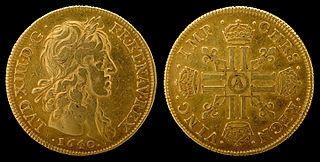
The Louis d'or is any number of French coins first introduced by Louis XIII in 1640. The name derives from the depiction of the portrait of King Louis on one side of the coin; the French royal coat of arms is on the reverse. The coin was replaced by the French franc at the time of the revolution and later the similarly valued Napoléon. The actual value of the coins fluctuated according to monetary and fiscal policy, but in 1726 the value was stabilized.

The Coinage Act of 1792, passed by the United States Congress on April 2, 1792, created the United States dollar as the country's standard unit of money, established the United States Mint, and regulated the coinage of the United States. This act established the silver dollar as the unit of money in the United States, declared it to be lawful tender, and created a decimal system for U.S. currency.
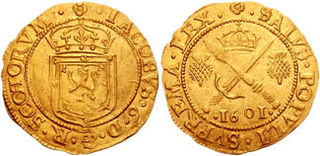
The pound was the currency of Scotland prior to the 1707 Treaty of Union between the Kingdom of Scotland and the Kingdom of England, which created the Kingdom of Great Britain. It was introduced by David I, in the 12th century, on the Carolingian monetary system of a pound divided into 20 shillings, each of 12 pence. The Scottish currency was later devalued relative to sterling by debasement of its coinage. By the time of James III, one pound Scots was valued at five shillings sterling.
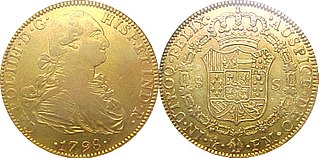
The doubloon was a two-escudo gold coin worth approximately $4 or 32 reales, and weighing 6.766 grams of 22-karat gold . Doubloons were minted in Spain and the viceroyalties of New Spain, Peru, and Nueva Granada. As the Spanish escudo succeeded the heavier gold excelente as the standard Spanish gold coin, the doubloon therefore succeeded the doble excelente or double-ducat denomination.

Pistole is the French name given to a Spanish gold coin in use from 1537; it was a doubloon or double escudo, the gold unit. The name was also given to the Louis d'Or of Louis XIII of France, and to other European gold coins of about the value of the Spanish coin. One pistole was worth approximately ten livres or three écus, but higher figures are also seen. The derivation is uncertain; the term may come from the Czech píšťala, or from the Italian town of Pistoia; either way, it was originally spelled pistolet and originated in military slang, and probably has the same root as pistol.

The Conventionstaler or Konventionstaler, was a standard silver coin in the Austrian Empire and the southern German states of the Holy Roman Empire from the mid-18th to early 19th-centuries. Its most famous example is the Maria Theresa thaler which is still minted today. The Conventionsgulden was equivalent to a 1⁄2Conventionsthaler.

The Reichsthaler, or more specifically the Reichsthaler specie, was a standard thaler silver coin introduced by the Holy Roman Empire in 1566 for use in all German states, minted in various versions for the next 300 years, and containing 25–26 grams fine silver.
From c. 1124 until 1709 the coinage of Scotland was unique, and minted locally. A wide variety of coins, such as the plack, bodle, bawbee, dollar and ryal were produced over that time. For trading purposes coins of Northumbria and various other places had been used before that time; and since 1709 those of the Kingdom of Great Britain, and then of the UK.
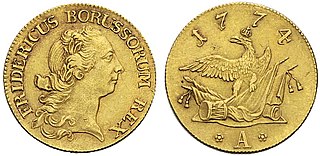
The Friedrich d'or was a Prussian gold coin (pistole) nominally worth 5 silver Prussian thalers. It was subsequently copied by other North German states under their own rulers' names and valued at 4.8-5 silver North German thalers.

The Great Debasement (1544–1551) was a currency debasement policy introduced in 1544 England under the order of Henry VIII which saw the amount of precious metal in gold and silver coins reduced and in some cases replaced entirely with cheaper base metals such as copper. Overspending by Henry VIII to pay for his lavish lifestyle and to fund foreign wars with France and Scotland are cited as reasons for the policy's introduction. The main aim of the policy was to increase revenue for the Crown at the cost of taxpayers through savings in currency production with less bullion being required to mint new coins. During debasement gold standards dropped from the previous standard of 23 karat to as low as 20 karat while silver was reduced from 92.5% sterling silver to just 25%. Revoked in 1551 by Edward VI, the policy's economic effects continued for many years until 1560 when all debased currency was removed from circulation.
The five rin coin (五厘青銅貨) was a Japanese coin worth one two-hundredth of a Japanese yen, as 5 rin equalled +1⁄2 sen, and 100 sen equaled 1 yen. These coins were a successor to the equally valued half sen coin which was previously minted until 1888. Overall, the history of the five rin coin is brief as they were only minted from 1916 to 1919 before being devalued monetarily. They were later demonetized by the end of 1953 and are now widely available for collectors.
A pistole was a Scottish gold coin minted in 1701 under the reign of King William III. Along with the half-pistole it was the last gold coin minted for Scottish coinage. With a weight of 106 grains, the coin was equal to 12 Scottish pounds.
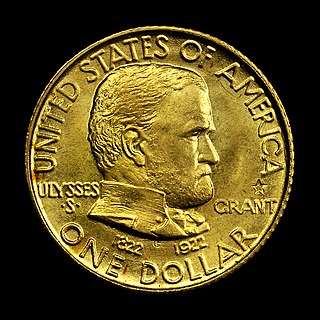
The Grant Memorial coinage are a gold dollar and silver half dollar struck by the United States Bureau of the Mint in 1922 in honor of the 100th anniversary of the birth of Ulysses S. Grant, a leading Union general during the American Civil War and later the 18th president of the United States. The two coins are identical in design and were sculpted by Laura Gardin Fraser.
The North German thaler was a currency used by several states of Northern Germany from 1690 to 1873, first under the Holy Roman Empire, then by the German Confederation. Originally equal to the Reichsthaler specie or silver coin from 1566 until the Kipper und Wipper crisis of 1618, a thaler currency unit worth less than the Reichsthaler specie was first defined in 1667 and became widely used after adoption of the Leipzig currency standard of 1690.
References
- ↑ "Scottish Coins". predecimal.com. Retrieved 13 July 2017.
- ↑ Whitelaw, Alexander (1846). The popular encyclopedia; or, 'Conversations Lexicon': [ed. by A. Whitelaw from the Encyclopedia Americana. Glasgow: Blackie & Sons. p. 279.
- ↑ Pantologia: A New Cabinet Cyclopaedia. London. 1819. p. 457.
